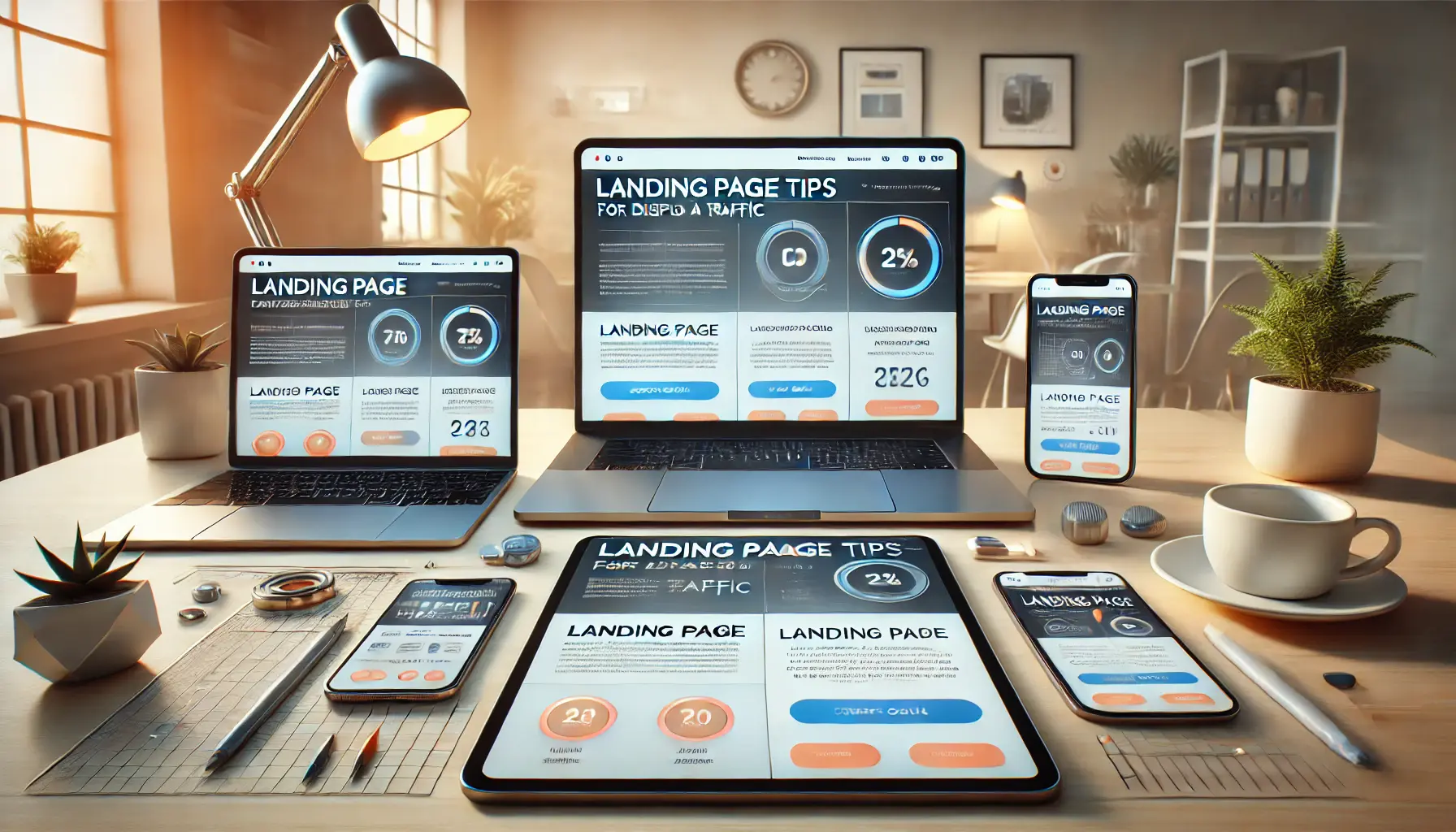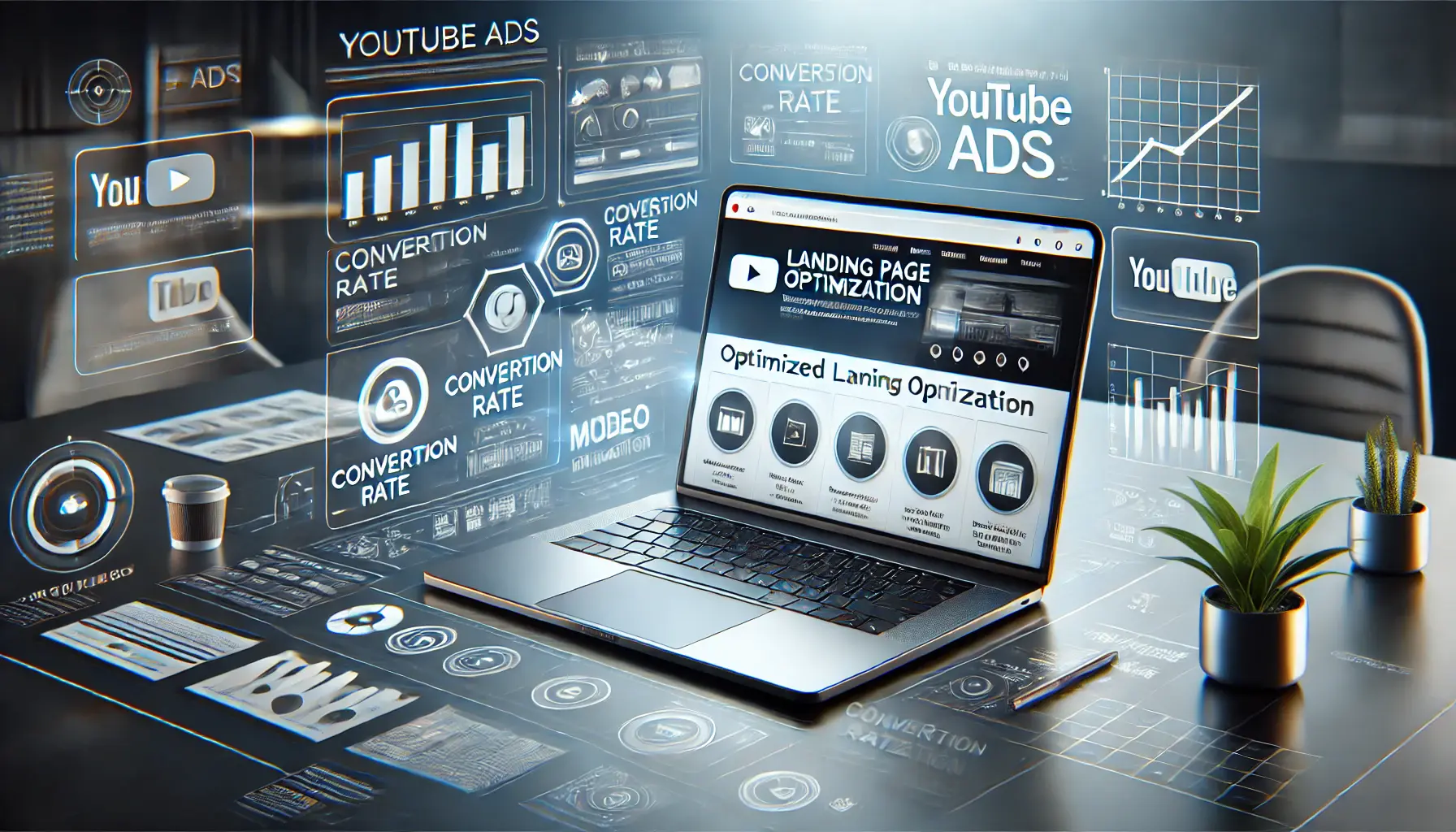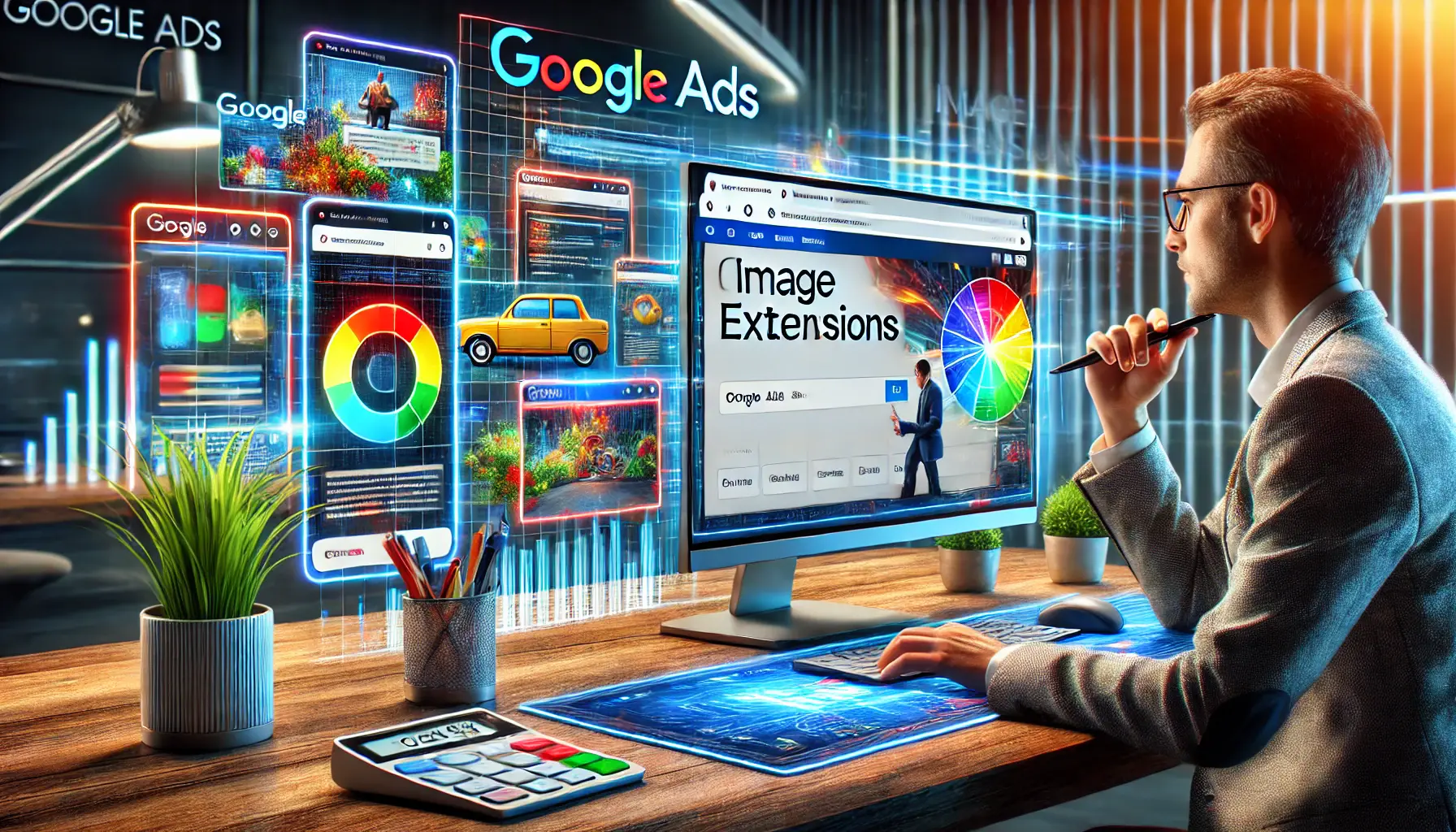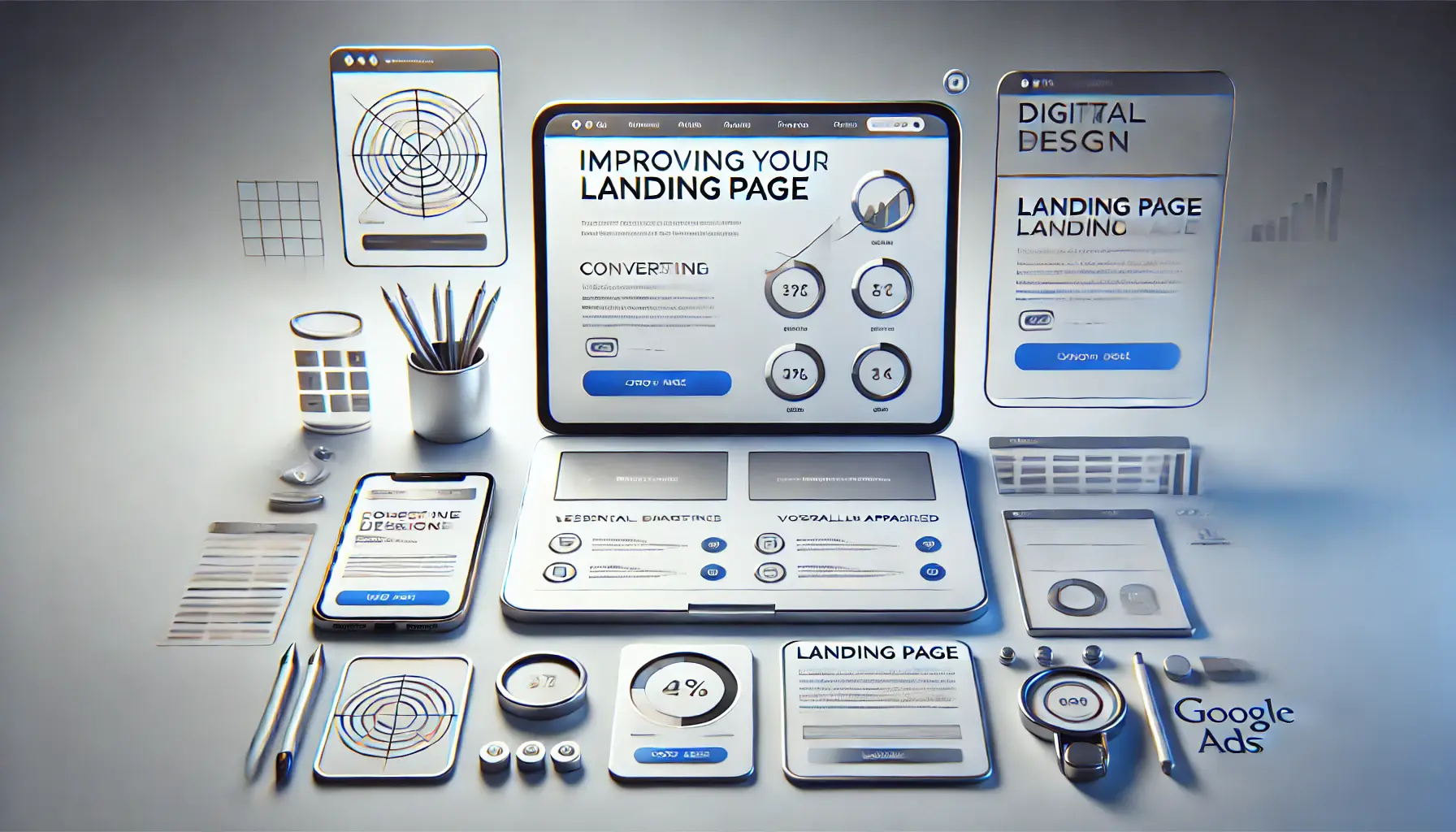In the fast-moving world of digital marketing, creating a high-converting landing page for your display ad traffic can make or break the success of your campaign.
Among so many competing elements, it’s very important to understand what truly drives engagement and leads to conversions.
In this post, we’ll explore practical and actionable landing page tips to ensure your display ad traffic generates measurable results.
A highly optimized landing page will maintain visitor engagement and increase your campaign’s return on investment.
Whether you’re running Google Ads, social media campaigns, or other digital ad formats, implementing the right strategies is key to making your landing page work harder for you.
- Optimize Page Load Speed for Better Engagement
- Craft a Clear and Compelling Call-to-Action
- Design for Visual Appeal and Consistency
- Focus on Mobile-Friendly Design
- Include Social Proof and Trust Signals
- Mastering Landing Page Tips for Display Ad Traffic Success
- FAQs on Landing Page Tips for Display Ad Traffic
Optimize Page Load Speed for Better Engagement
Did you know that even a one-second delay in page load time can significantly reduce your conversion rates?
In today’s fast-paced digital landscape, visitors expect your landing page to load almost instantly.
When it doesn’t, they’re likely to leave, costing you both potential customers and ad spend.
Here are a few ways to improve your page load speed and keep your visitors on the page:
- Compress Images: Large image files can slow down your page. Use tools to reduce their size without losing quality.
- Minimize HTTP Requests: Reduce the number of files your page needs to load by merging multiple CSS and JavaScript files together.
- Enable Browser Caching: Allow returning visitors to load your page faster by storing elements locally.
- Use a Content Delivery Network (CDN): Distribute your content across multiple servers to route users to the closest server, ensuring faster access globally.
- Optimize Your Hosting Solution: Invest in a reliable hosting provider that guarantees uptime and fast speeds.
Remember, the quicker your page loads, the more likely visitors will stay, engage, and convert.
Prioritizing load speed is one of the most effective landing page tips for maximizing your display ad traffic’s potential.
Optimizing page load speed ensures visitors stay engaged and reduces bounce ratesThe percentage of visitors who leave a website after viewing only one page.. Compress images, minimize HTTP requestsRequests made by a browser to fetch resources from a server, such as images or scripts., and use reliable hosting to enhance performance.
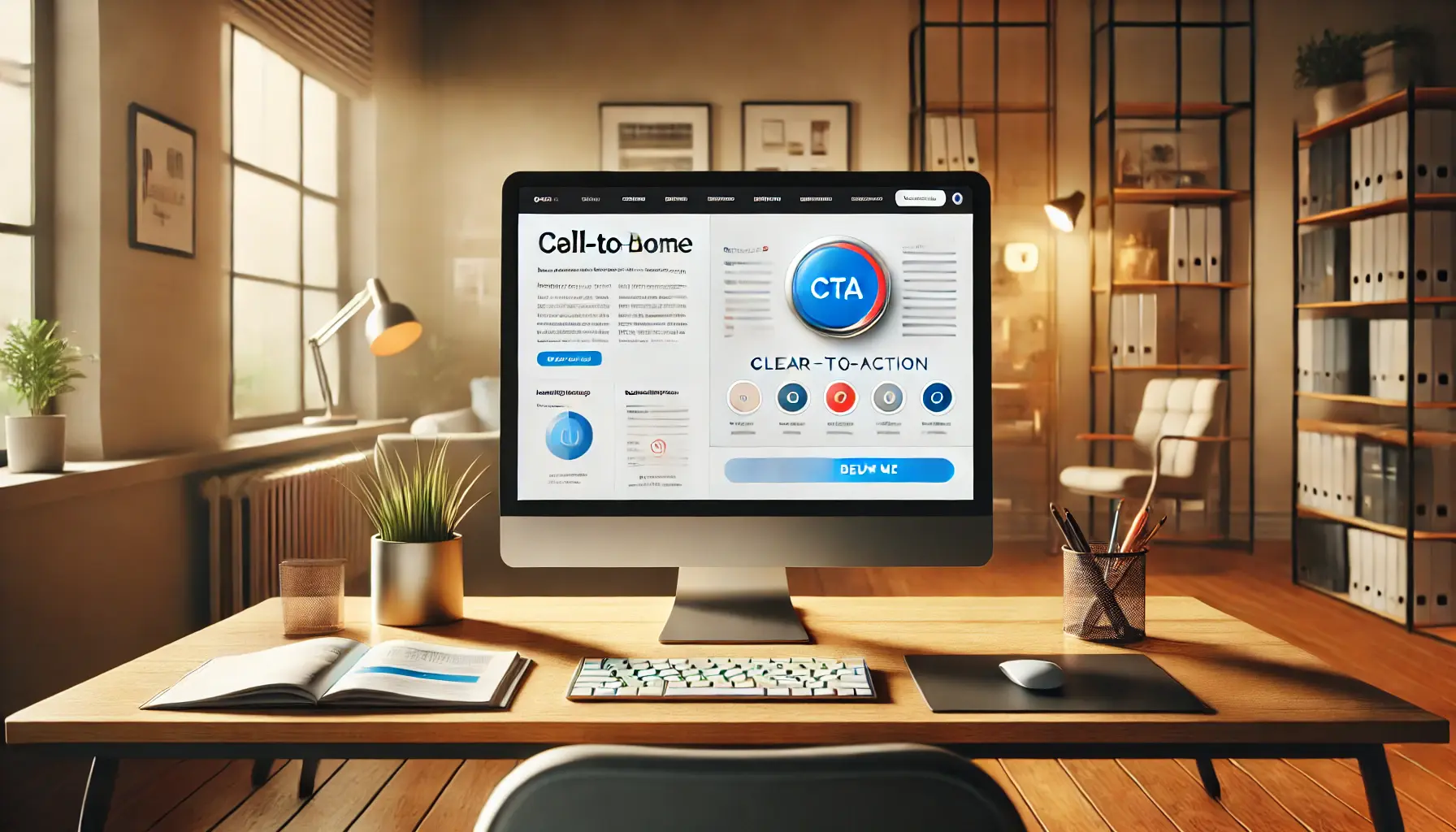
Create impactful call-to-action designs that drive user engagement.
Craft a Clear and Compelling Call-to-Action
Your landing page’s call-to-action (CTA) is the driving force for conversions.
It guides visitors on what action to take next—whether it’s completing a purchase, signing up for a newsletter, or downloading a resource.
Without a clear and compelling CTA, your landing page may fail to achieve its goals, even if it attracts a large amount of display ad traffic.

Highlight the power of well-designed call-to-actions for effective user engagement.
What Makes a Call-to-Action Effective?
An effective CTA is concise, action-oriented, and directly aligned with your landing page’s goal.
Use verbs that inspire action, such as “Get Started,” “Sign Up Now,” or “Download Free Guide.” Ensure the CTA communicates the value the visitor will receive by clicking on it.
For example, instead of a generic “Submit” button, use a phrase like “Get Your Free Ebook” or “Start Your Free Trial Today.” These CTAs create excitement and clearly communicate the benefit.
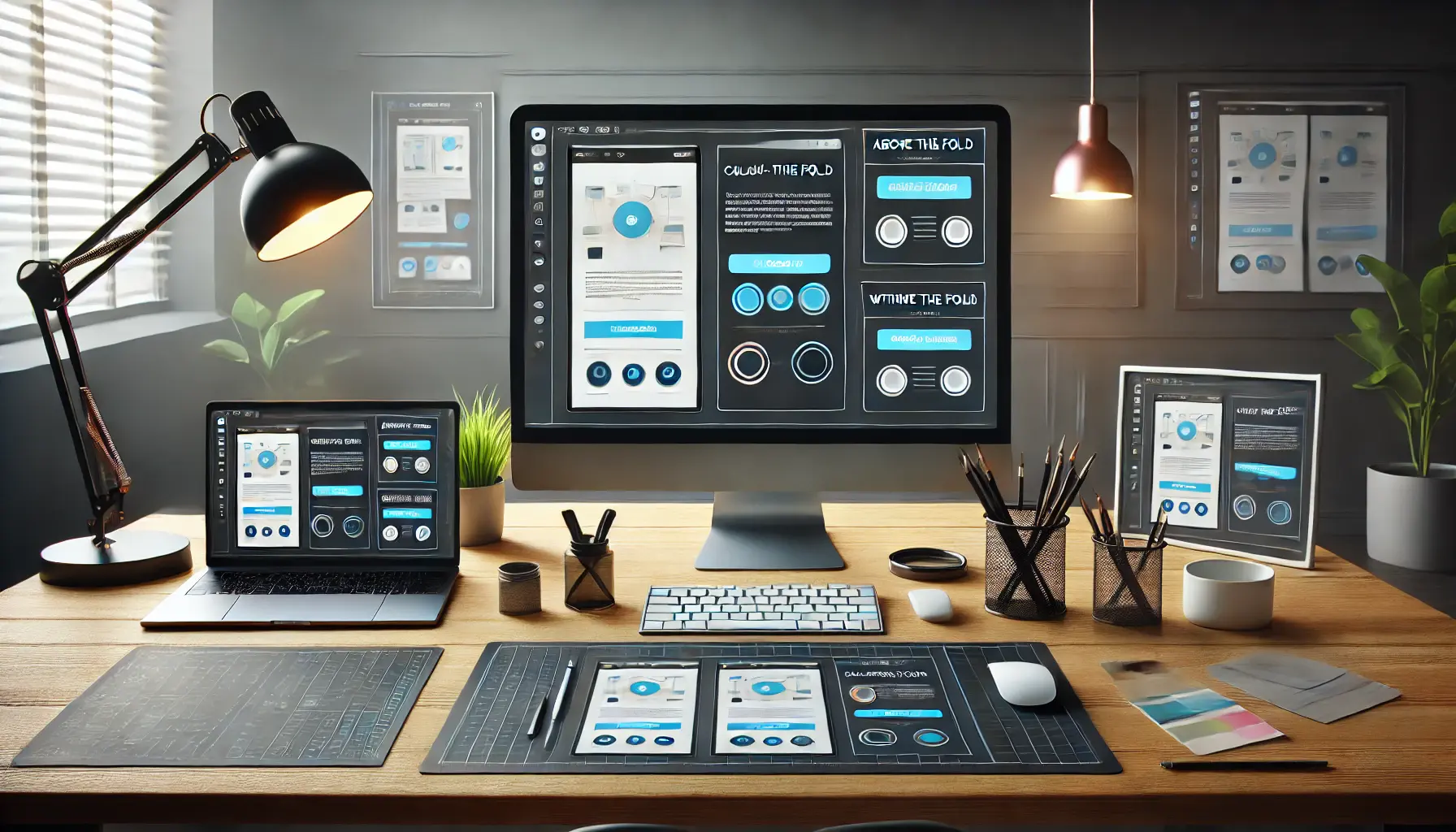
Explore the impact of strategic CTA placement for improved conversions.
Placement Strategies for High-Impact CTAs
Where you place your CTA on the landing page can significantly impact its effectiveness.
Follow these best practices for CTA placement:
- Above the Fold: Place your primary CTA where it’s immediately visible without requiring the visitor to scroll.
- Within Content Sections: If your page is longer, add secondary CTAs strategically throughout the page to re-engage visitors.
- At the End of the Page: Include a final CTA for users who read through all the content and are ready to take action.

Discover impactful examples of call-to-action designs for better user engagement.
Examples of CTAs That Drive Results
Here are some real-world examples of CTAs that have proven effective:
- “Claim Your Discount Today”: Perfect for promotional campaigns to create urgency.
- “Join Our Community for Free”: Great for building a subscriber base.
- “Learn More About Our Services”: Encourages exploration for service-based businesses.
- “Try It Free for 30 Days”: A common and effective CTA for subscription-based models.
Ensure your CTA stands out visually on the page by using contrasting colors, bold fonts, and enough white space around it.
A clear and compelling CTA is one of the most powerful landing page tips for maximizing conversions from your display ad traffic.
CTAs guide visitors toward desired actions. Use strong verbs and clear value propositions to drive conversions effectively. Place them strategically for maximum impact.

Achieve a professional look with visually appealing and consistent landing page designs.
Design for Visual Appeal and Consistency
The design of your landing page is critically important for capturing visitors’ interest and retaining it.
A visually appealing and consistently designed page builds trust and directs visitors toward the desired action.
On the other hand, a cluttered or mismatched design can confuse users, leading to high bounce rates and missed opportunities.

Visual hierarchy guides user focus on key elements of a landing page for better engagement.
Importance of Visual Hierarchy on Landing Pages
Visual hierarchy ensures that visitors naturally focus on the most important elements of your landing page.
Key components like headlines, call-to-action buttons, and value propositions should be prominently displayed.
Utilize larger fonts, bold colors, and strategic placement to guide users’ attention.
For example, placing your headline at the top and using contrasting colors for your CTA button makes it immediately noticeable.
Organizing your content in a logical flow prevents visitors from feeling overwhelmed and keeps them engaged.
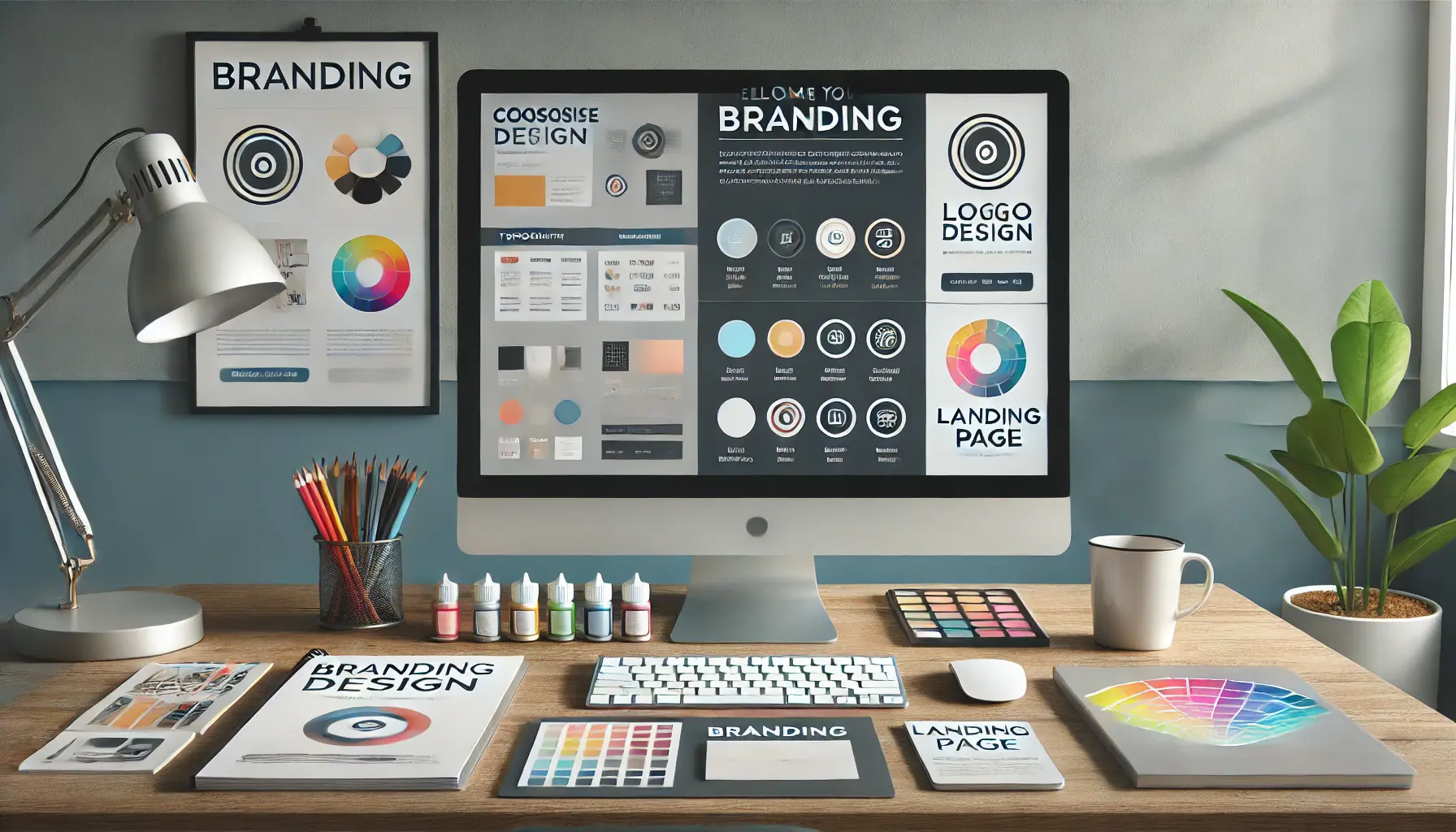
Maintain consistent branding with cohesive designs and elements.
Tips for Maintaining Branding Consistency
Consistency in branding is essential for establishing credibility and reinforcing your brand identity.
Your landing page should align with your overall marketing materials in terms of color schemes, fonts, and tone.
- Use Consistent Colors: Stick to your brand’s primary and secondary colors to create a unified appearance.
- Maintain Font Styles: Use the same font types and sizes throughout to ensure readability and professionalism.
- Align Tone of Voice: Match the tone of your copy to your brand’s voice, whether it’s formal, friendly, or playful.

Enhance readability with carefully chosen colors and fonts.
Using Colors and Fonts to Enhance Readability
The right combination of colors and fonts can make your landing page visually appealing and easy to navigate.
Here’s how you can optimize your design:
- Choose Readable Fonts: Use clean, sans-serif fonts that are easy to read across all devices.
- Limit Font Variations: Stick to two or three font styles to maintain a clean and organized look.
- Leverage Contrast: Use high-contrast color combinations for text and backgrounds to enhance readability.
- Incorporate White Space: Leave adequate space between elements to avoid a cramped layout and make content easier to focus on.
Designing for aesthetic appeal and consistency ensures a professional look and a smooth user experience.
By following these landing page tips, you can improve visitor engagement and drive more conversions from your display ad traffic.
A visually appealing and consistent design builds trust and improves engagement. Use branding, visual hierarchyThe arrangement of elements on a page to guide the viewer's attention in order of importance., and white space effectively.
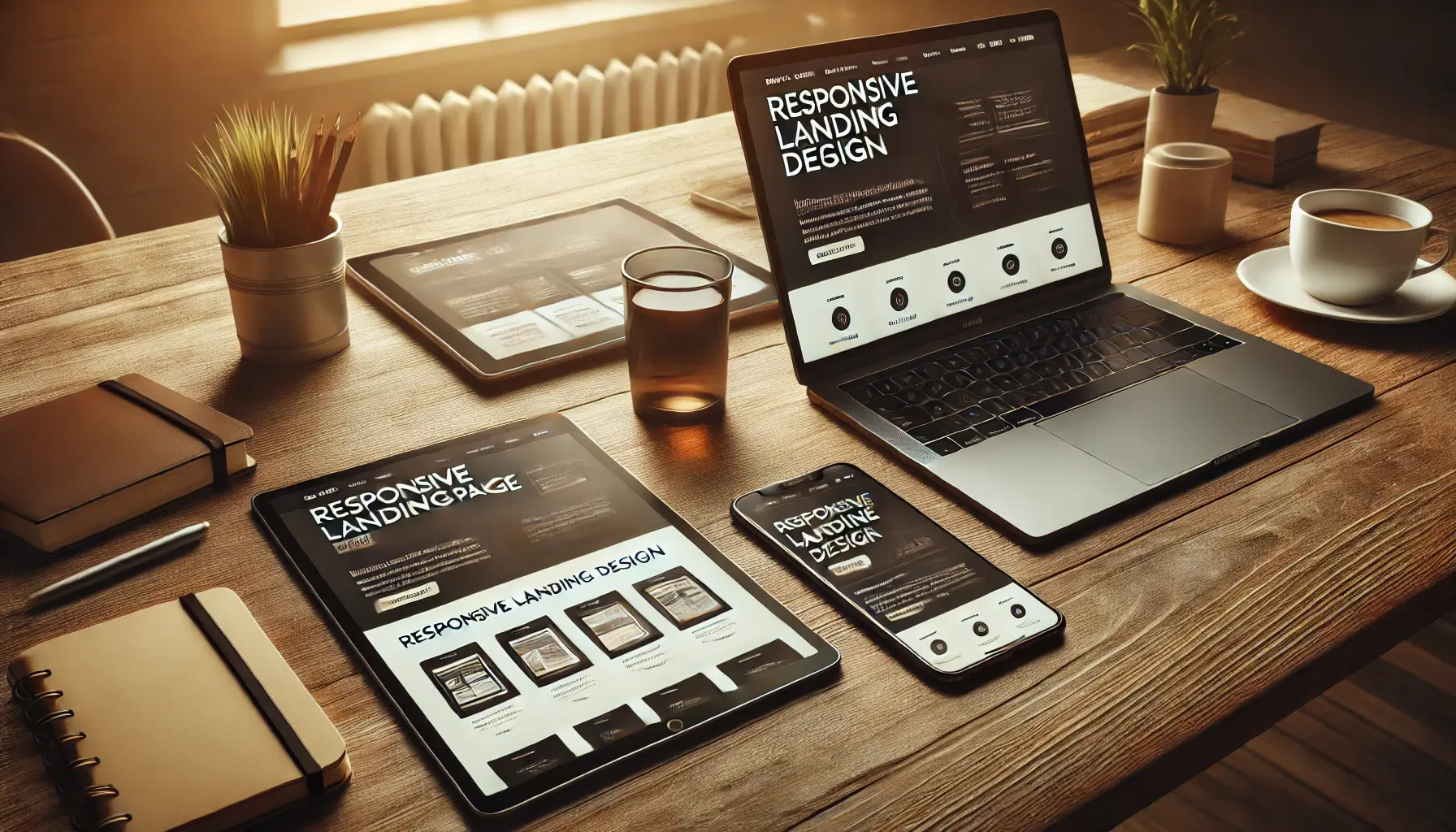
Ensure your landing page is mobile-friendly for a seamless user experience.
Focus on Mobile-Friendly Design
With the increasing dominance of mobile devices, making your landing page mobile-friendly is not an option but a necessity.
A significant portion of display ad traffic comes from smartphones and tablets, and if your landing page isn’t optimized for these devices, you risk losing a large number of potential customers.
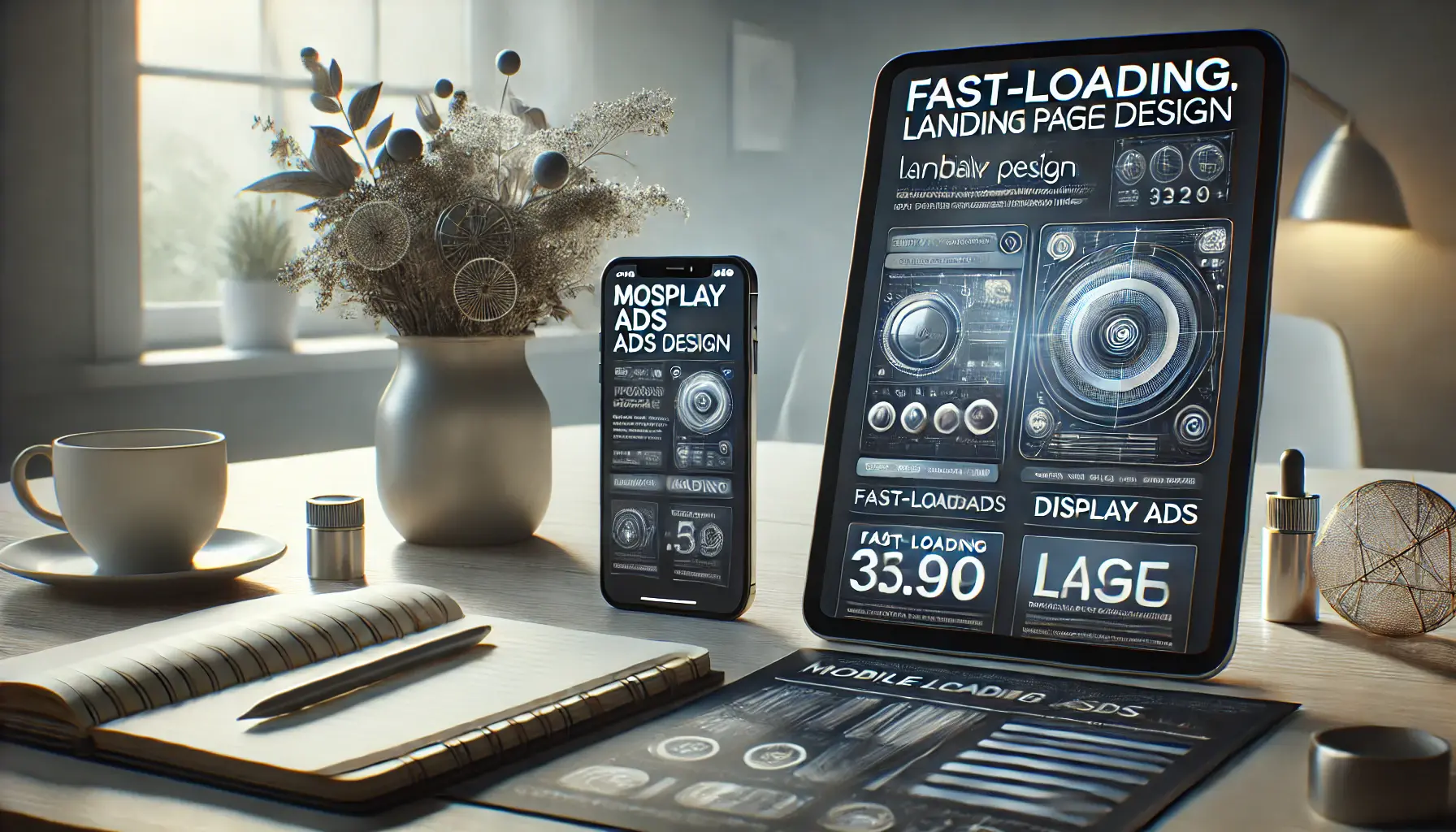
Maximize ad effectiveness with mobile-optimized designs tailored for modern users.
Why Mobile Optimization is Crucial for Display Ads
Mobile users expect fast, seamless, and visually appealing experiences.
Pages that are difficult to navigate or require excessive zooming can lead to frustration and high bounce rates.
By optimizing your landing page for mobile devices, you create a smoother user journey that keeps visitors engaged.
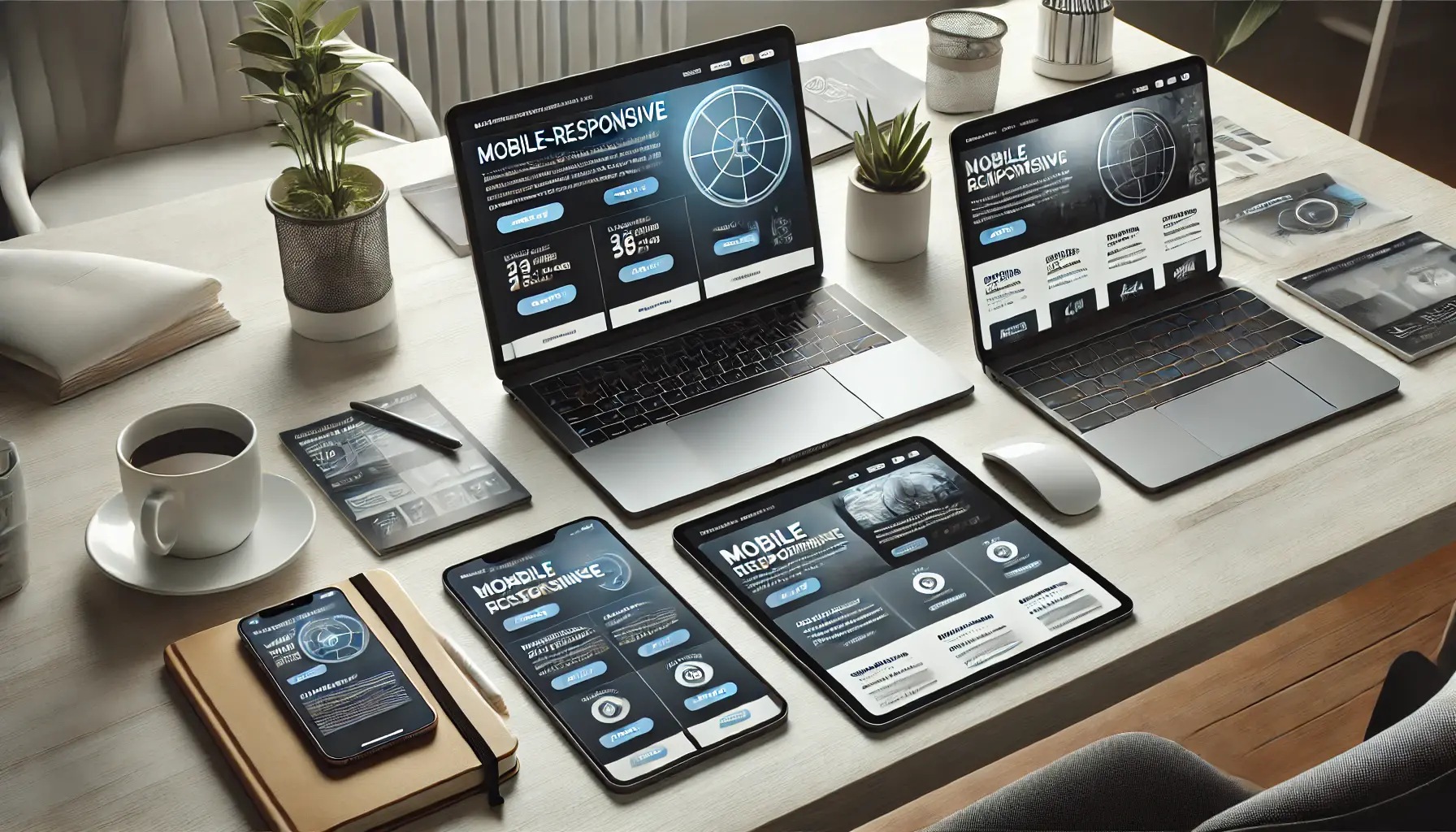
Implement best practices for mobile-responsive designs to improve user experience.
Best Practices for Mobile-Responsive Landing Pages
To create a mobile-friendly landing page that converts, follow these best practices:
- Use a Responsive Design: Ensure your page automatically adjusts to fit any screen size, whether it’s a smartphone, tablet, or desktop.
- Simplify Navigation: Keep menus minimal and intuitive. Avoid complicated navigation schemes that may leave mobile users frustrated.
- Optimize Images: Compress images to make them load faster on mobile devices without sacrificing quality.
- Use Large, Clickable Buttons: Make CTAs and other interactive elements easily tappable on smaller screens.
- Minimize Pop-Ups: Pop-ups can be intrusive on mobile devices. If you use them, ensure they are easy to close and do not interfere with the user experience.
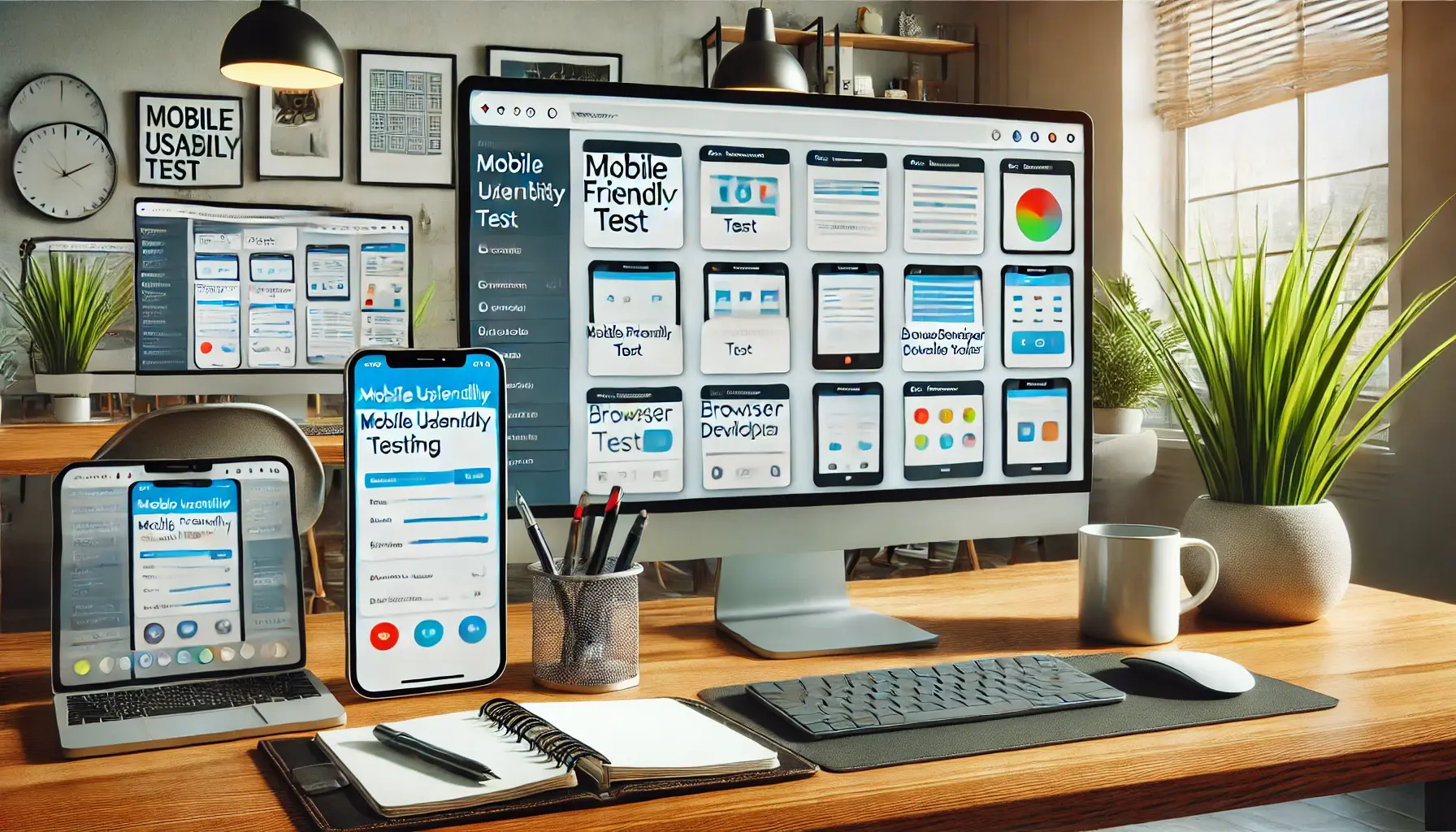
Utilize testing tools to ensure mobile usability and optimize user experience.
Testing Tools for Ensuring Mobile Usability
Testing your landing page across various devices and screen sizes is critical for ensuring mobile usability.
Here are some tools you can use:
- Google’s Mobile-Friendly Test: Quickly check whether your page meets mobile optimization standards.
- Browser Developer Tools: Simulate different screen sizes and resolutions directly in your browser.
- PageSpeed Insights: Analyze how fast your page loads on mobile devices and receive actionable improvement suggestions.
- User Testing Platforms: Use services like UserTesting to gather insights from real users about their mobile experience.
By prioritizing mobile-friendly design, you cater to the growing number of users who browse and convert on their smartphones and tablets.
Following these landing page tips ensures maximum conversions from your display ad traffic while providing a smooth and enjoyable experience for mobile users.
Mobile-friendly design is crucial for capturing traffic from smartphones and tablets. Use responsive layouts, simplify navigation, and avoid intrusive pop-ups.

Build trust and credibility with social proof and trust signals on your landing page.
Include Social Proof and Trust Signals
Social proof and trust signals are essential for convincing visitors to take action on your landing page.
These elements reassure users about the credibility and reliability of your product or service, which is crucial for turning display ad traffic into conversions.
People are more likely to trust a business that others have positively endorsed.
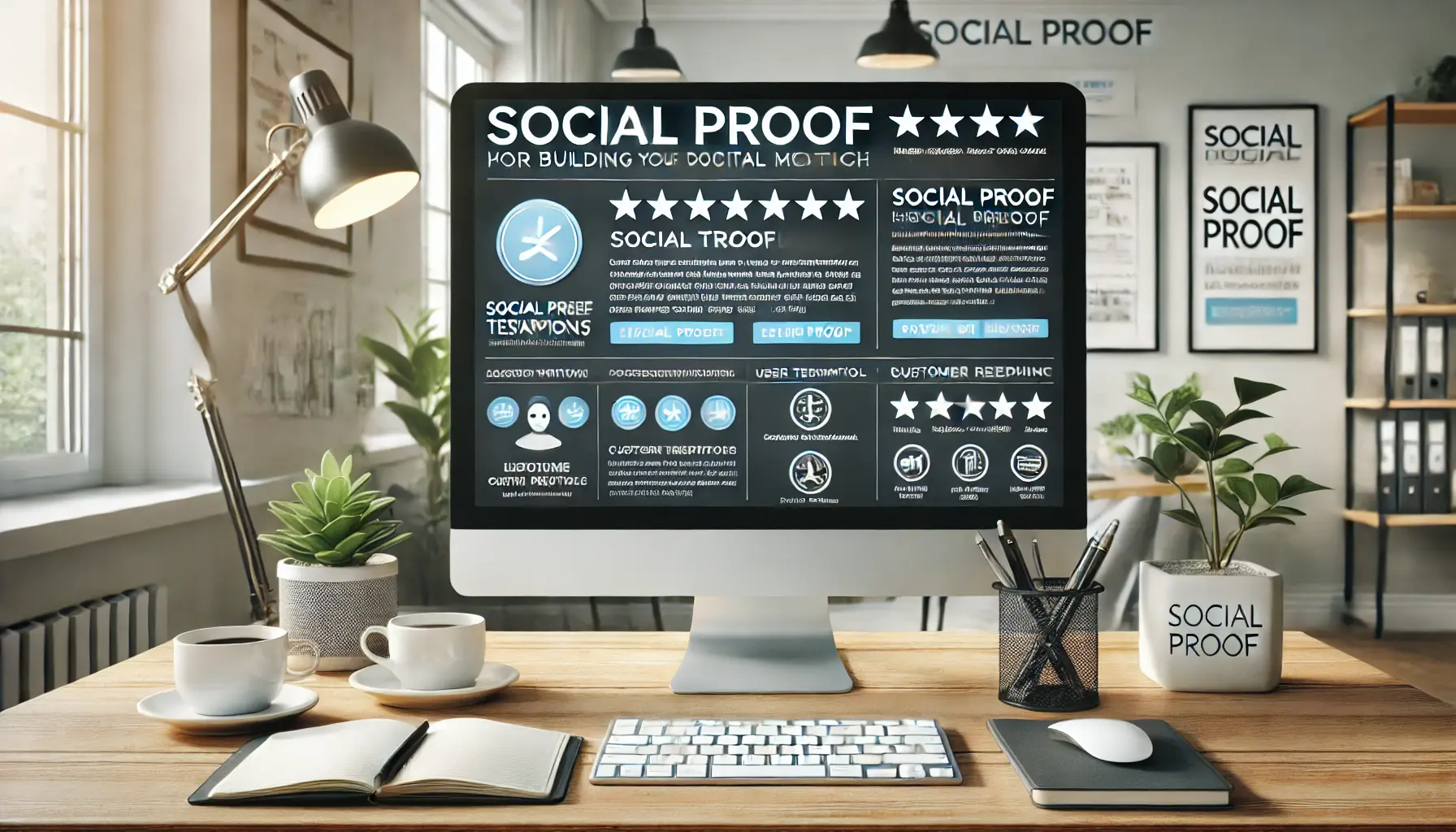
Use social proof to build trust and credibility with your audience.
The Role of Social Proof in Building Trust
Social proof is a psychological phenomenon where people look to others’ actions or opinions to guide their decisions.
This can be achieved on landing pages by displaying user testimonials, reviews, case studies, or even user-generated contentContent created and shared by users, often showcasing their experiences with a product or service. that highlights the value and credibility of your product.
For example, adding a customer testimonial or showing the number of satisfied users helps build trust for new visitors and encourages them to convert.
Displaying logos of well-known clients or partners can also enhance your credibility and authority.
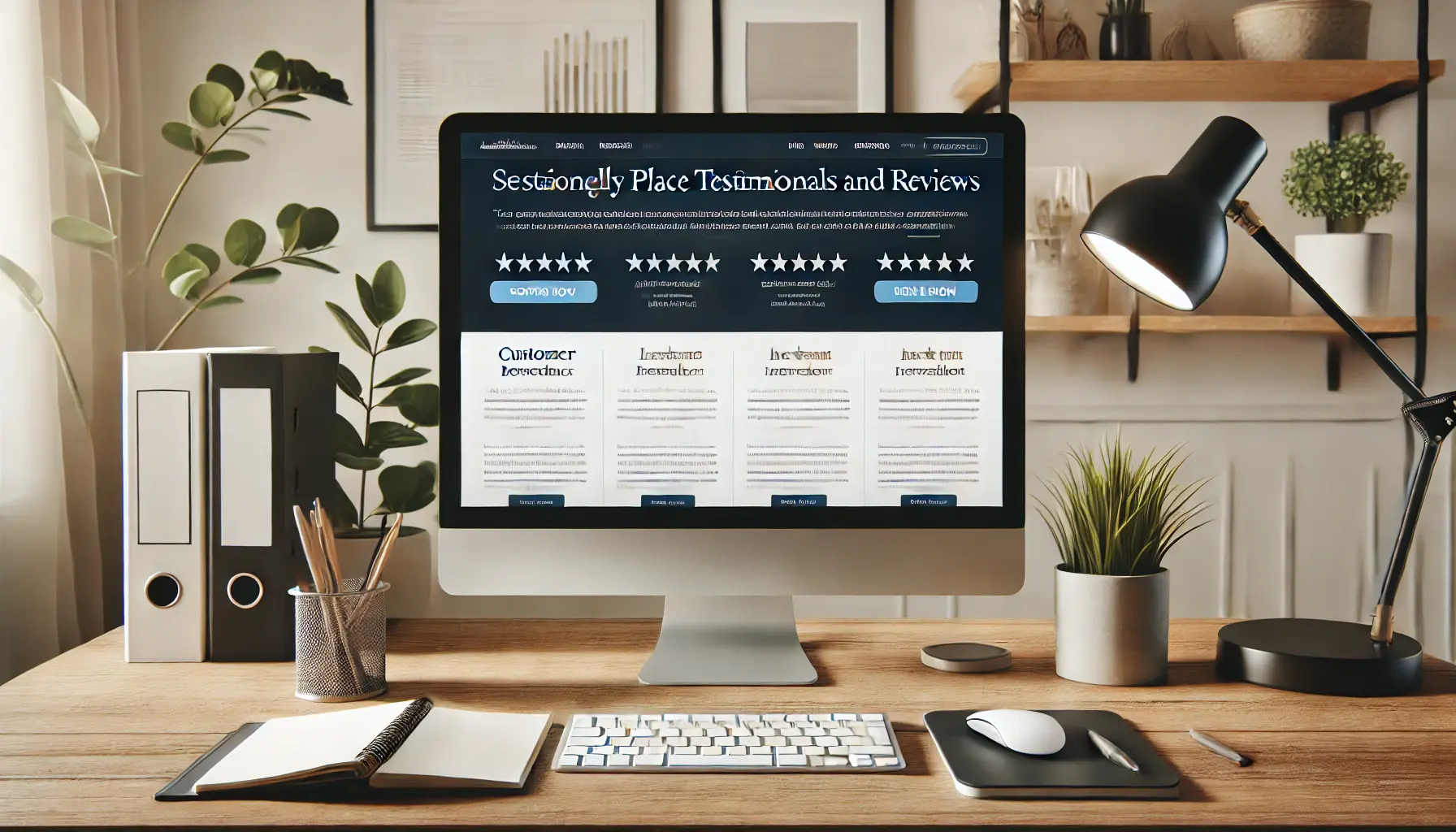
Strategically place testimonials and reviews to build trust and encourage conversions.
Where to Place Testimonials and Reviews
Strategic placement of testimonials and reviews can significantly improve their impact.
Consider these best practices:
- Above the Fold: Place one or two compelling testimonials near the top of your landing page to grab attention early.
- Near the Call-to-Action: Position reviews or case studies close to your CTA to provide reassurance and reduce hesitations.
- Throughout the Page: Scatter testimonials in various sections of your page to reinforce trust as visitors scroll down.
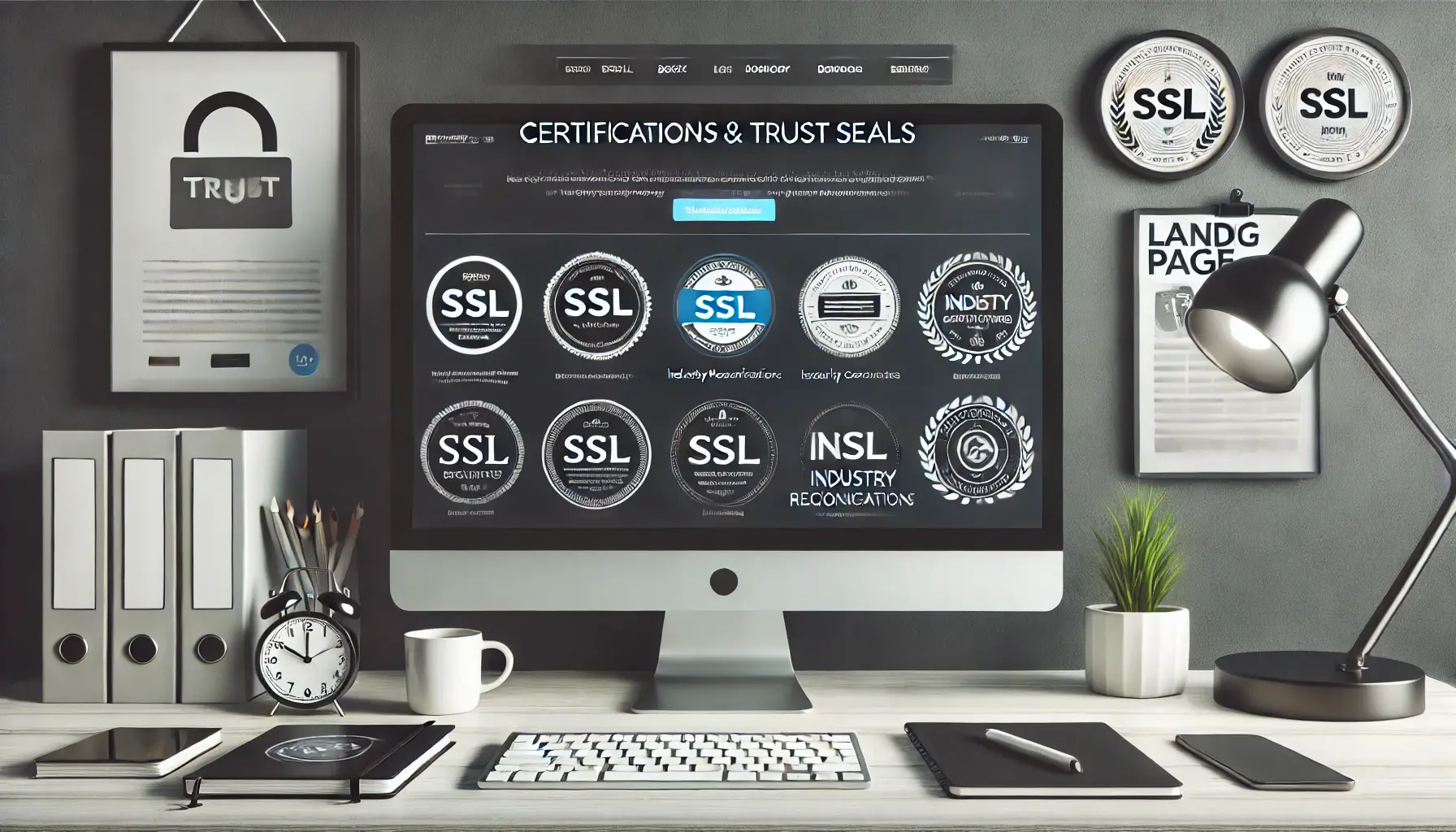
Enhance trust and credibility with certifications and security seals on your landing page.
How Certifications and Seals Impact Credibility
Displaying certifications, awards, or trust seals can further boost confidence in your brand.
These elements act as third-party validations that support your claims and demonstrate the high quality of your business.
- SSL Certificates: Highlight that your site is secure by displaying an SSL badge, especially if you handle sensitive user information.
- Industry Recognitions: Showcase awards or recognitions your business has received to build authority and trust.
- Money-Back Guarantees: Include guarantees to reassure visitors that their satisfaction is your top priority.
Incorporating social proof and trust signals into your landing page design is one of the most effective landing page tips for building credibility and converting display ad traffic.
By proving your reliability and value through these elements, you can leave a lasting impression and ensure meaningful engagement with your audience.
Social proof and trust signals like testimonials and certifications reassure visitors and boost conversions. Strategically place them near CTAs and throughout your page.
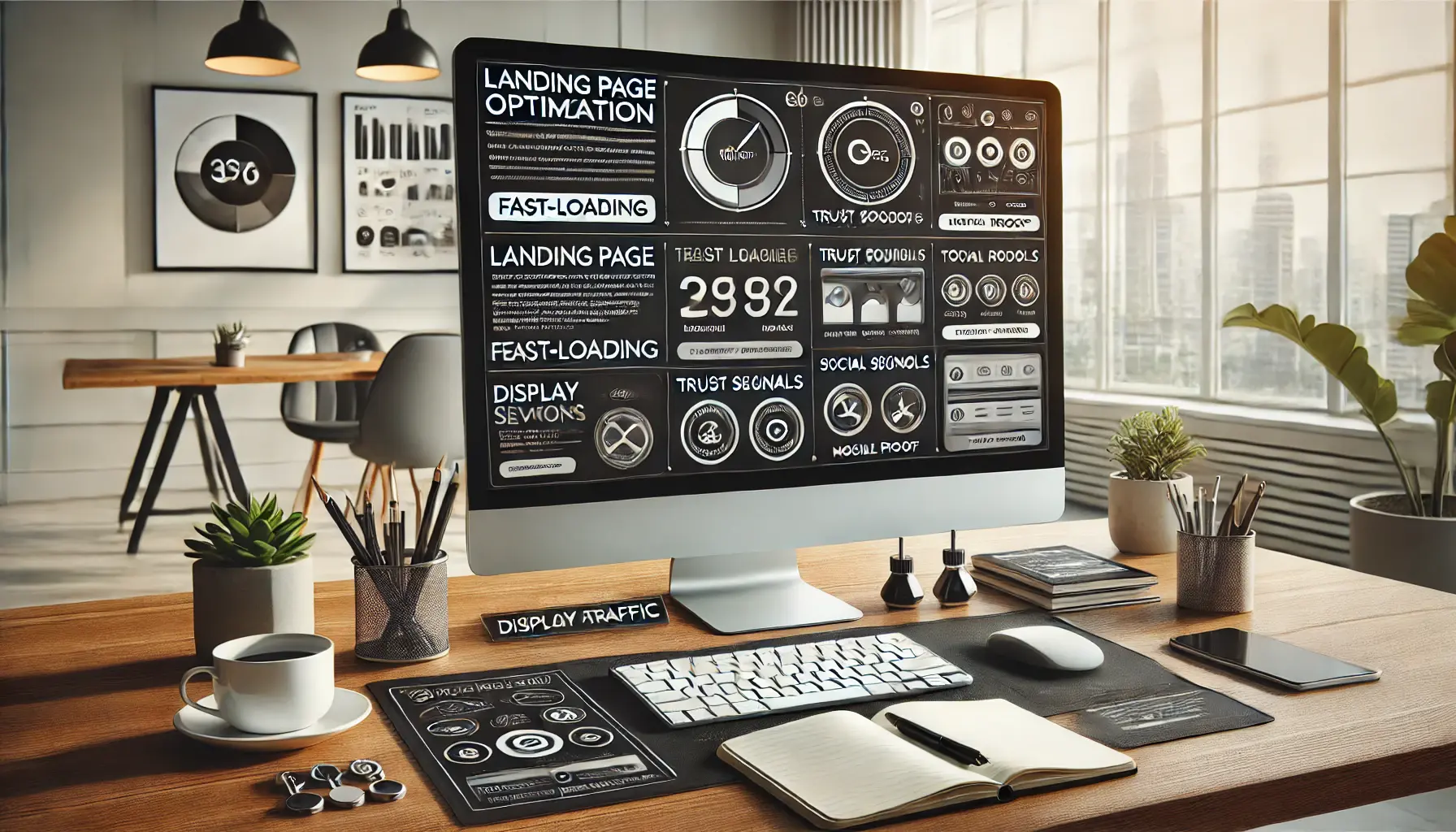
Master the art of landing page optimization to drive success in display ad traffic.
Mastering Landing Page Tips for Display Ad Traffic Success
Creating the best landing page for display ad traffic involves a delicate balance between design, functionality, and trust-building elements.
Every detail plays an important role in engaging visitors and guiding them toward conversion.
Let’s recap the essential landing page tips covered in this article to ensure your efforts lead to measurable success.
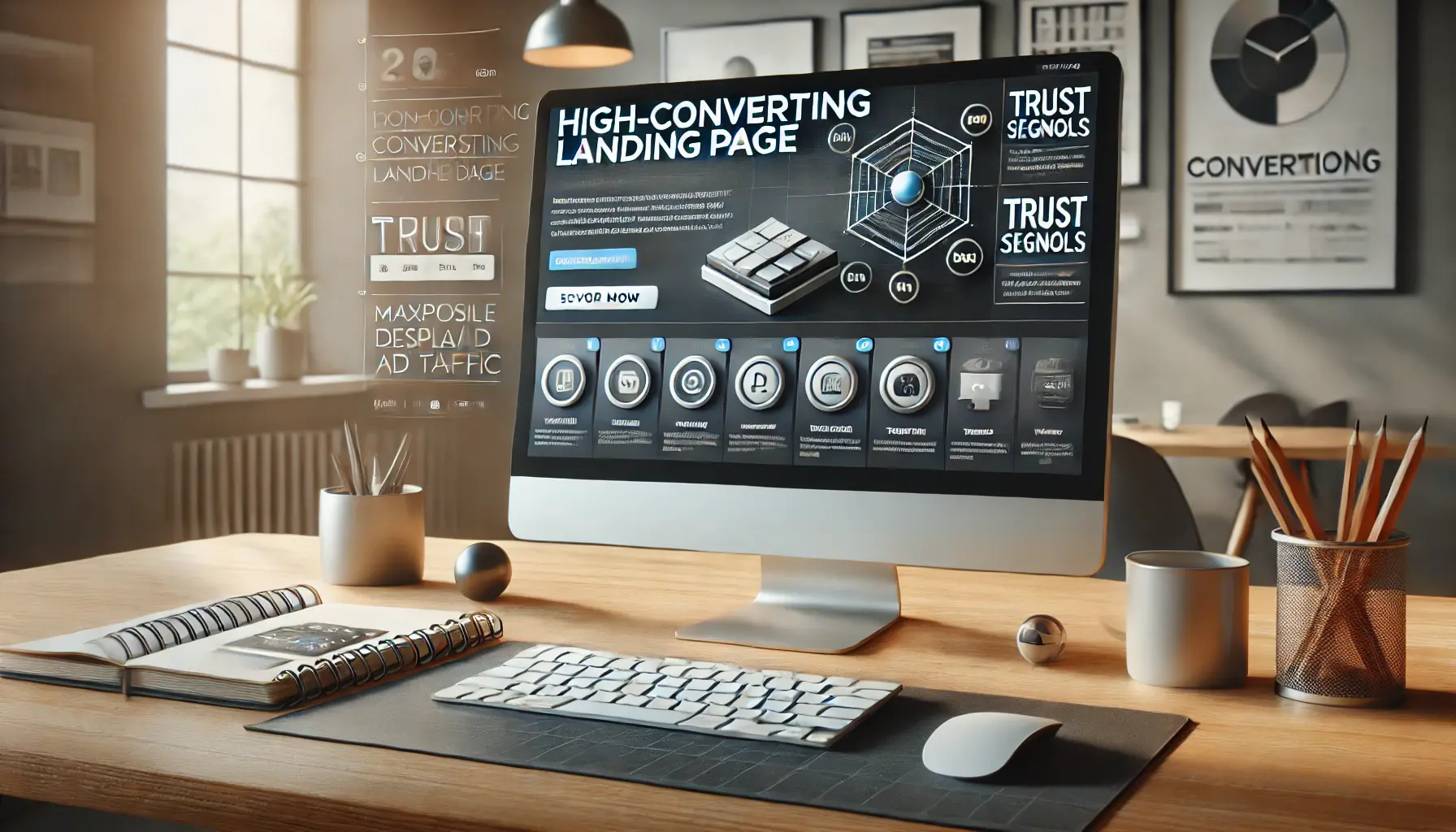
Maximize conversions by focusing on key landing page elements.
Key Takeaways for a High-Converting Landing Page
Here are the critical elements to focus on when optimizing your landing page for display ad traffic:
- Optimize Page Load Speed: A fast-loading page ensures visitors stay engaged and reduces bounce rates. Compress images, minimize HTTP requests, and invest in a reliable host.
- Design a Clear and Compelling CTA: Your call-to-action needs to be action-oriented and prominently placed. Use strong verbs and clear value propositions to drive conversions.
- Design Appealingly and Consistently: Ensure the design is cohesive and representative of your brand. Enhance user experience with visual hierarchy, consistent colors, and readable fonts.
- Focus on Mobile-Friendly Design: Your page should be responsive to fit mobile users. Simplify navigation, use large clickable buttons, and avoid intrusive elements like pop-ups.
- Incorporate Social Proof and Trust Signals: Add testimonials, reviews, certifications, and security badges to build trust. Strategically place these elements to reinforce credibility and encourage action.
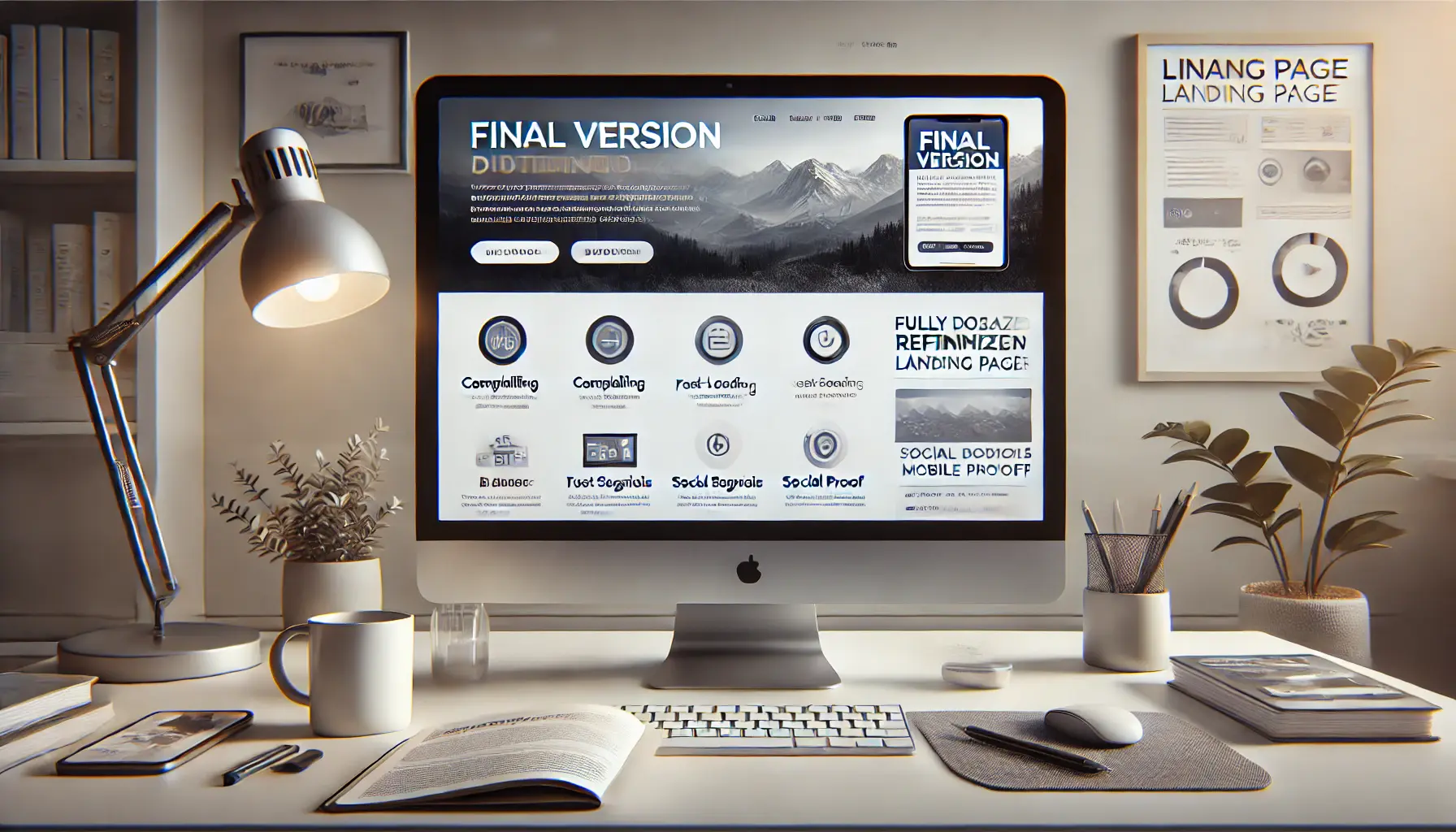
Make final refinements to your landing page for optimal performance in display ad campaigns.
Final Thoughts on Landing Page Optimization
Integrating these landing page tips will greatly enhance your ability to convert display ad traffic into meaningful engagement and sales.
A well-designed landing page is more than just a digital destination; it’s a powerful tool to build trust, deliver value, and guide prospects toward your marketing objectives.
Remember to continuously test your landing page’s performance and analyze the results.
Use A/B testing to determine what resonates best with your audience.
Stay flexible and make data-driven decisions to refine your approach and achieve even better results.
By focusing on speed, design, usability, and trust, your landing page will turn visitors into loyal customers, maximizing the impact of your display ad campaigns and driving long-term success.
Recap key tips: Optimize load speed, craft strong CTAs, design consistently, prioritize mobile usability, and incorporate trust signals to maximize conversions.
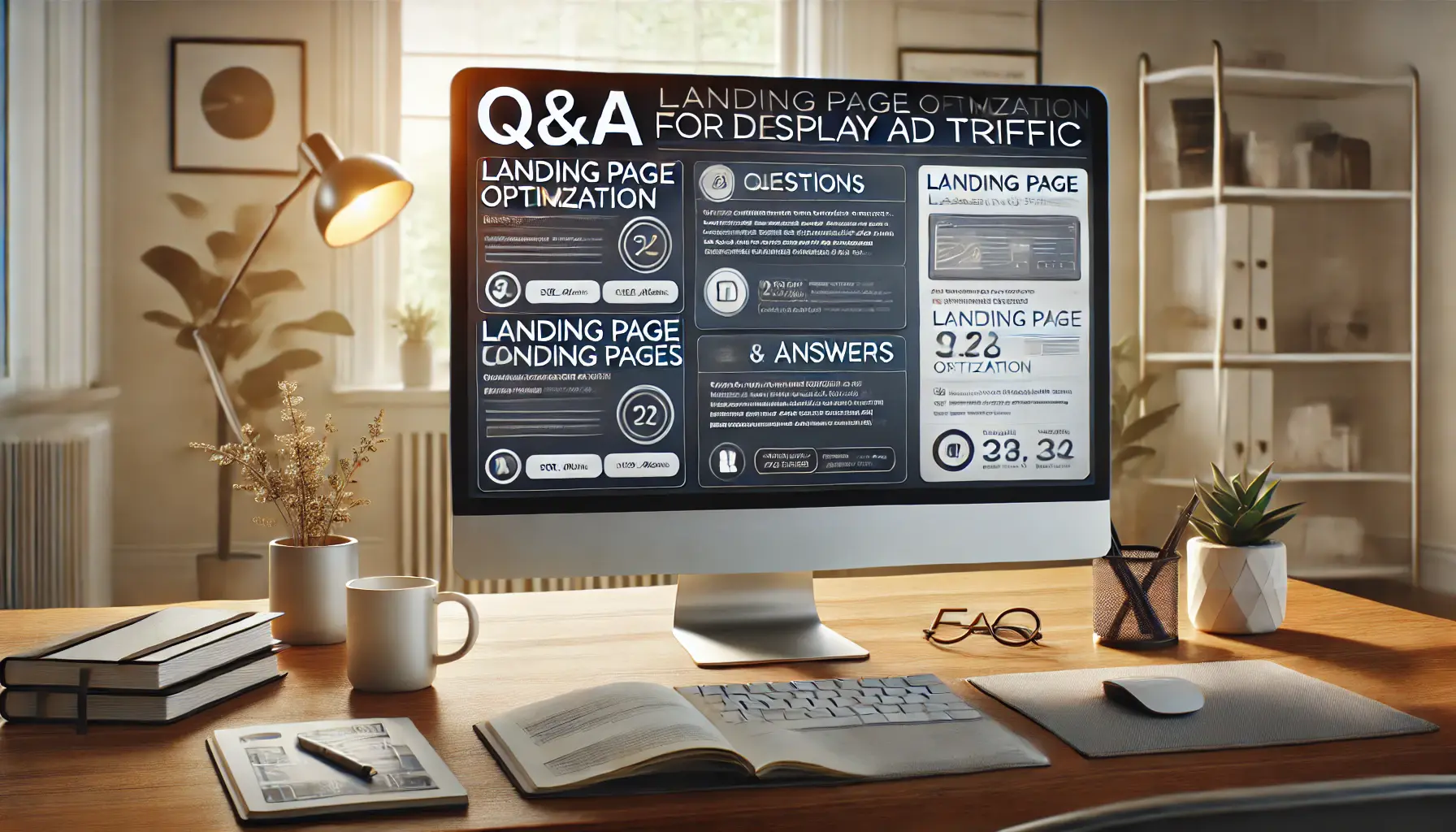
Address key landing page optimization questions with a structured FAQ section.
Your campaigns can be managed by an agency specialized in Google Ads, check out our service page.
FAQs on Landing Page Tips for Display Ad Traffic
Here are some common questions and quick answers to help you optimize your landing pages effectively for display ad traffic.
An effective landing page is visually appealing, loads quickly, features a compelling CTA, and builds trust through social proof and credibility elements like testimonials and certifications.
Mobile-friendly design ensures that your landing page is accessible, usable, and visually optimized for smartphone and tablet users, which form a significant portion of display ad traffic.
Compress images, minimize HTTP requests, use a content delivery network (CDN), and invest in reliable hosting to improve page load speed and reduce bounce rates.
A CTA guides visitors to take a desirable action, such as making a purchase or subscribing.
It should be clear, action-oriented, and easily noticeable.
Social proof, such as testimonials, reviews, and user-generated content, builds trust and reassures visitors of your product or service’s reliability, encouraging conversions.
Tools like Google’s Mobile-Friendly Test, PageSpeed Insights, and A/B testing platforms can identify areas for improvement and ensure optimal performance.
